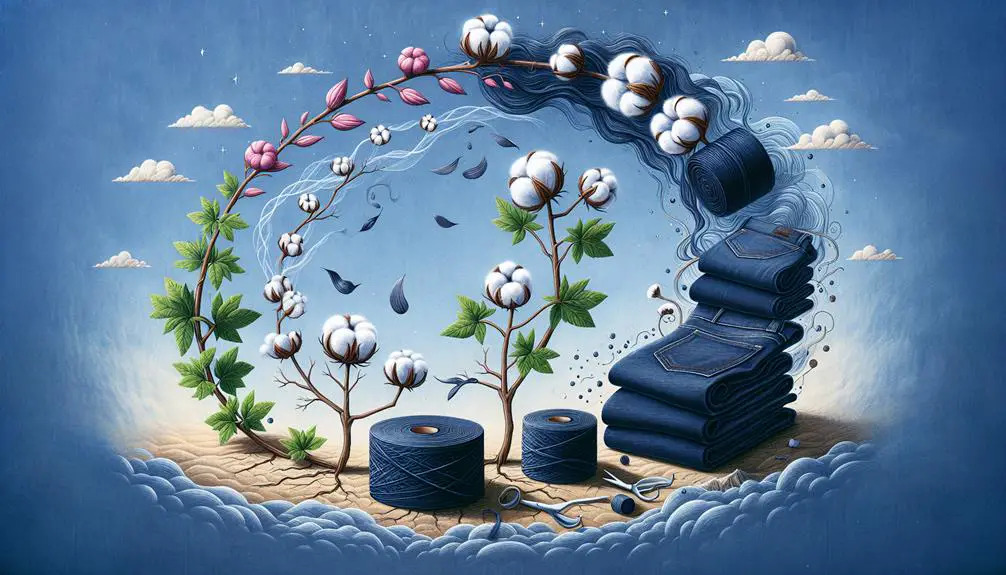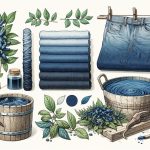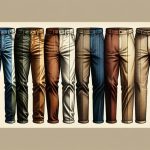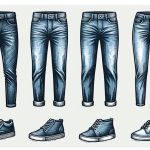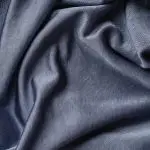I've always been fascinated by denim, the go-to fabric for my favorite pair of jeans. At its core, denim's made from cotton, which explains its unmatched comfort and durability. But it's the twill weave that gives it that classic diagonal pattern, and the indigo dyeing process that blesses it with its iconic blue color. What's really intriguing, though, is how adding synthetic fibers like polyester or a bit of elastane can transform the fabric, adding stretch and enhancing durability. Let's explore how these elements come together to create the denim we love, and perhaps uncover some surprises about its versatility and evolution along the way.
Table of Contents
Key Takeaways
- Denim is primarily made of cotton, which ensures durability and breathability.
- It incorporates synthetic fibers like polyester for added stretch and durability.
- Elastane or spandex is included for comfort and shape retention.
- The unique diagonal pattern in denim results from the twill weaving technique.
- Indigo dyeing process is used to achieve denim's signature blue hue.
Jeans Origins
Denim's journey into fashion history began in the 1870s when Levi Strauss and Jacob Davis first used it to craft jeans. These two visionaries saw the potential in a sturdy cotton fabric, traditionally woven in a twill weave, where the warp yarn was dyed using an indigo dyeing process while the weft thread remained white. This unique method gave denim its characteristic blue exterior and white interior. But here's the kicker: they didn't stop at just creating tough pants; they reinforced them with copper rivets at critical stress points. This genius move was a game-changer.
I'll tell ya, the addition of those copper rivets was a stroke of brilliance. It turned denim trousers from just another piece of clothing into an indispensable tool for laborers. The patent they snagged in 1873 for these denim jeans? It wasn't just a piece of paper; it was a ticket to immortality in the fashion world. Before long, denim jeans had exploded in popularity, becoming the go-to choice for workers and eventually, well, just about everybody. The durability, comfort, and style they offered were unmatched. It's wild to think about how far we've come from those early days, isn't it?
Traditional Denim Fabric
Moving on from the origins of jeans, let's talk about what traditional denim fabric is really made of.
First off, cotton plays a huge role in giving denim its strength and comfy feel.
We'll also look into how it's woven and why that indigo dye makes it uniquely blue.
Cotton's Crucial Role
At the heart of every pair of classic jeans is cotton, a material that's not just durable but also breathes life into the fabric's iconic look and feel. Here's why cotton is king in the world of denim:
- Durability & Breathability: Cotton's natural strength gives denim its ruggedness, while its breathability adds unmatched comfort.
- Twill Weaving Magic: The unique diagonal pattern of denim comes from twill weaving, using cotton yarns that enhance the fabric's durability and feel.
- Indigo Dyeing: Cotton's adaptability makes it perfect for the indigo dyeing process, creating denim's signature blue hue and ensuring the color holds well with wear.
There's no denying cotton's pivotal role in giving denim its timeless appeal and functionality.
Weaving Process Explained
Let's dive into how traditional denim gets its unique and durable texture from the weaving process. This method isn't just any old way of making fabric; it's a precise technique that gives denim its strength and character.
Using 100% cotton, the twill weave pattern is what sets denim apart. This pattern creates those noticeable diagonal lines on the fabric, thanks to its warp-faced design. Specifically, we're talking about a 3×1 right hand twill, where three warp yarns lie on top for every single weft yarn.
This not only contributes to denim's durability and breathability but also ensures it can stand up to the rigors of everyday wear. The strength this weaving process imparts is exactly why denim remains a go-to for durability.
Indigo Dye Application
Traditionally, denim gets its signature blue color from being dyed with indigo, a process that's both ancient and labor-intensive. Here's the lowdown on how it all goes down:
- Indigo Dye Application: The indigo dye is applied to the warp yarn before it even hits the loom. This traditional technique sets the stage for that classic denim look we all know and love.
- Weaving Magic: After the dye application, the warp yarn is woven with weft yarn. This step is crucial for bringing out those iconic fading patterns that add character over time.
- Labor of Love: It's a labor-intensive process, but it's what gives denim its timeless appeal. This method has been rocking the denim production world for centuries, proving some things just don't go out of style.
Lighter Denim Jeans
Switching gears to lighter denim jeans, let's talk about what sets them apart.
We'll explore how their fabric composition impacts comfort and style.
We'll also discuss why their color might fade differently than heavier denim.
And we'll share the best ways to keep them looking great.
It's all about finding that perfect balance between durability and a comfy fit.
Fabric Composition
Why do lighter denim jeans feel so comfy? It's often because they're made from cotton blends with a touch of elastane. This mix is the secret behind their irresistible appeal. Let's break it down:
- Cotton for Breathability: The foundation of denim is cotton, ensuring that comfort and breathability are never compromised.
- Elastane for Stretch: A sprinkle of elastane introduces that much-needed stretch, enhancing flexibility and allowing you to move without restraint.
- Blends for Modern Style: The fusion of cotton with synthetic fibers creates a fabric that's not only soft and comfortable but also aligns with contemporary fashion trends.
This composition makes lighter denim jeans a standout choice for anyone seeking a blend of comfort, style, and practicality.
Color Fading Techniques
Lighter denim jeans get their cool, faded look from techniques like enzyme wash, acid wash, and sandblasting. Let's dive into how these methods give our denim that sought-after vintage vibe.
Enzyme wash uses natural enzymes to break down the indigo dye, creating a softer, worn-in look. It's great for achieving that gently aged appearance without harsh chemicals.
Acid wash steps it up with chemicals, like chlorine, making those distinctive, high-contrast patterns that scream retro fashion.
Sandblasting is more about texture, using abrasive materials to physically wear the fabric down, adding to that distressed aesthetic we love.
These color fading techniques not only lighten denim but add character, blending perfectly into contemporary fashion with a nod to the past.
Care and Maintenance
To keep your faded denim looking sharp, it's crucial to nail the care and maintenance routine. Since lighter jeans often mix cotton with elastane for that comfy stretch, preserving their look and feel means sticking to a few key practices:
- Always wash inside out – This minimizes color loss and protects the surface from direct friction.
- Opt for cold water – Hot water can break down the elastane, reducing flexibility and comfort over time.
- Skip the dryer – Air drying is your best bet to keep the fibers from shrinking or warping.
Indigo Dyeing Magic
Indigo dyeing's magic lies in its ability to turn denim into the iconic blue we all love, through a process that's both art and science. It's a traditional technique that's been around for ages, and honestly, it's what gives denim its soul. By dipping the fabric repeatedly in a bath of indigo dye, we get that deep, rich blue that's become synonymous with denim fabric. But here's the kicker: indigo dye molecules don't fully penetrate the cotton fibers. Instead, they just cling to the surface, which is why your favorite pair of jeans fades and ages in such a cool, unique way over time.
Rope dyeing is another trick of the trade, creating patterns and shades that make each piece of denim unique. It's not just about dunking fabric into dye; it's about crafting a look that's as individual as the person who wears it. This labor-intensive process, steeped in rich history, is what sets denim apart. It's not just fabric; it's a canvas that tells a story, with indigo dyeing playing the lead role in creating those timeless blues we can't get enough of.
Sustainable Denim
While we've been celebrating the rich blues of traditional denim dyeing, it's also important to talk about how the denim industry is evolving with sustainable practices. Sustainable denim is becoming the gold standard for those of us who care not only about style but also about our planet. It's all about making jeans that don't cost the earth—literally.
Sustainable denim uses a mix of strategies to reduce its environmental footprint:
- Materials: It leans heavily on organic cotton and recycled fibers. This choice alone significantly cuts down on the harmful chemicals and vast amounts of water typically used in conventional cotton farming.
- Production Techniques: Brands are getting smart with innovative techniques like laser finishing and ozone washing. These methods aren't just for show; they minimize water usage and reduce the need for harsh chemicals.
- Ethics and Transparency: There's a strong push for ethical sourcing and fair labor practices. Sustainable denim isn't just about being kinder to the environment; it's also about ensuring that everyone in the supply chain is treated fairly.
The Blend That Elevates Jeans
Denim's evolution has brought in a mix of materials that not only enhance its comfort but also its durability and flexibility. At its core, denim is all about cotton, which scores high on breathability and comfort. But, let's not overlook the modern twist. The introduction of synthetic fibers, like polyester, has been a game changer. It's all about boosting that stretch while not skimping on durability.
Now, for those of us who live in our jeans, elastane or spandex is the real MVP. This addition means we're getting jeans that move with us, not against us. It's about comfort that lasts all day, without losing shape. And let's talk about the look. The traditional indigo dyeing process gives denim those unique aging patterns we all love. It's like your jeans are telling your story.
The twill weave, that's another piece of the puzzle. It's what gives denim its strength, its durability. This isn't just fabric; it's armor, in a way. But it's armor that ages gracefully, showing off patterns that are as unique as the person wearing them. It's this blend, this careful balance of materials, that elevates jeans from mere trousers to a canvas of personal expression.
Nurturing Your Denim Love
To keep your jeans looking and feeling great, it's crucial to know how to care for them properly. My love for denim goes beyond its comfortable and stylish appeal; understanding the fabric textures, the indigo dyeing process, and the twill weave technique has deepened my appreciation. Here's how I nurture my denim obsession:
- Wash Sparingly: To preserve the indigo dye and maintain the personalized wear patterns, I wash my jeans as infrequently as possible. This approach not only conserves water, aligning with sustainable practices, but it also helps the denim develop character over time.
- Air Dry Always: I never toss my jeans in the dryer. Instead, I air dry them to prevent shrinkage and preserve the integrity of the stretch denim or denim blends. This method keeps them comfortable and stylish for years.
- Spot Cleaning: For minor spills, spot cleaning is my go-to. It's a simple yet effective way to keep my jeans fresh without subjecting them to the rigors of a full wash cycle.
From Rebellion to Runway
Transitioning from a symbol of rebellion in the 1950s, denim has seamlessly strutted its way onto today's fashion runways. It's fascinating to think about how this sturdy material, made from 100% cotton fibers, has evolved. Known for its durability, breathability, and comfort, denim's journey from being the go-to attire for rebels without a cause to a must-have in everyone's wardrobe speaks volumes about its versatility and timeless appeal.
The indigo dyeing process, a unique characteristic of denim, not only gives it that iconic blue hue but also allows for a personalized wear pattern over time. I've noticed how my own jeans have molded to my body, creating a unique fit that's just mine. This adaptability is a testament to the fabric's enduring popularity.
Today, the denim industry continues to innovate, occasionally blending cotton with synthetic fibers like polyester for added stretch, without compromising on durability. As a fashion staple, denim's ability to reinvent itself while keeping its core characteristics intact is remarkable. From rugged workwear to high fashion, denim proves to be as versatile as it's comfortable, securing its spot on runways and in hearts globally.
Frequently Asked Questions
What Is Real Denim Made Of?
I've learned that real denim's primarily crafted from 100% cotton. This makes it super durable and breathable. It's spun and woven in a special way, often mixed with a bit of synthetic fiber for stretch.
Is Denim Made of 100% Cotton?
Yes, I've learned that denim is traditionally made of 100% cotton. This material gives it durability, comfort, and allows it to age well, creating unique wear patterns that make each piece uniquely mine over time.
What Fabric Is Used for Denim?
I've learned that denim's primarily made from cotton, giving it toughness and breathability. Modern versions might mix in synthetic fibers like polyester to boost those qualities. It's all about that comfy, durable twill weave.
What Is the Difference Between Denim and Jeans?
I've learned that denim's the fabric, while jeans are the actual pants made from it. Denim can make other clothing too, but jeans specifically refer to those denim pants we all know and love.
- Tetron Fabric for Marine Applications: Durability and Use Cases - June 18, 2025
- Tetron Fabric for Outdoor Furniture: Weather Resistance and Care - June 18, 2025
- Tetron Fabric for Wall Coverings: Style and Application Tips - June 18, 2025

